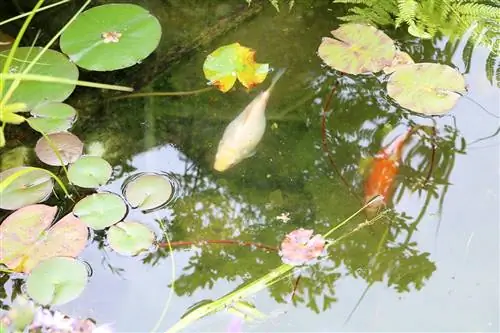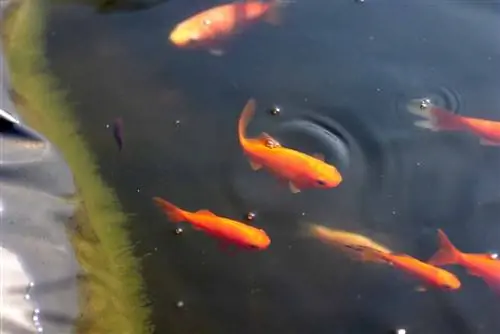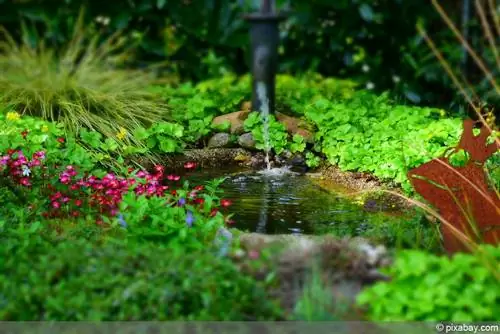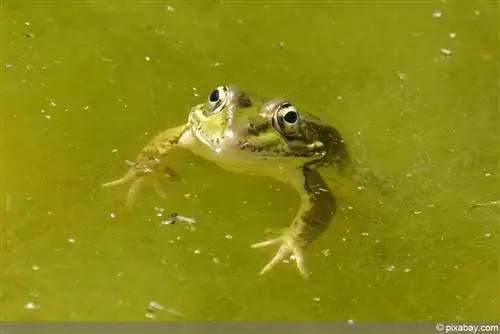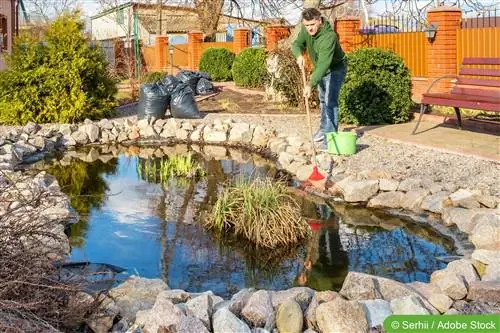- Author admin [email protected].
- Public 2023-12-17 03:39.
- Last modified 2025-01-24 12:45.
There are different methods to combat floating algae, but not all of them are equally recommended. We will tell you which measures are most effective and at the same time safe for aquatic animals and plants.
Cause of algae development
Floating algae are usually blue or green plants that are microscopic and float on the surface of the water. The water itself remains clear, whereas the surface is covered by a greenish shimmering veil. Floating algae usually appear in spring, as the supply of nutrients in the pond is particularly high at this time. But it's not just the season that is the cause of algae development:
Increased phosphorus content
A phosphorus content of around 0.0035 milligrams per liter can lead to algal blooms. Among other things, it rises when excess fish food and fish feces sink to the bottom. Likewise, when it rains, nutrient-rich soil can be washed into the pond, increasing the phosphorus content.
Water temperature and solar radiation
The increased solar radiation in spring and summer and the resulting rising water temperature also have a positive effect on algae development.
Dead algae
As soon as the algae die, they sink to the bottom and form the basis for the next algae bloom in the pond. This causes the cycle to repeat itself and the algae problems become more intense from year to year.
Too high pH
The ideal pH value of a pond is between 6.8 and 8.2. If this is too high, this encourages algae infestation.
Why remove algae?
Algae are not bad per se because they remove nutrients from the pond, but at the same time provide oxygen. The problem here is that throughout the day they remove as much oxygen from the water as they produce. This creates strong oxygen fluctuations between day and night.
Don't forget that the lack of oxygen poses a threat to other aquatic plants and fish. Floating algae also ensure an increased pH value and a lower KH value (carbon hardness). These factors are also not favorable for fish etc. For this reason, it is advisable to remove the floating algae. It is practical that there are different methods for this:
Skimming
Skimming algae can be particularly helpful in ponds that are still in the acclimatization phase, as plants and aquatic animals have not yet created a balance. It is therefore advisable to remove the algae right from the start by skimming them off. At the same time, it is also a good idea to remove leaves, pollen and other organic materials.
UV-C clarifier
A UV-C clarifier is a UV-C lamp that destroys the structure of the algae. In many cases, such a lighting medium is already integrated into the filter system, but it is also possible to buy it separately. It is important that the UV-C clarifier is installed in front of the filter so that the dead floating algae can be captured by the filter. The way a UV-C clarifier works is as follows: The water is passed through the luminous medium, where the genetic information of the algae is destroyed by ultraviolet light. The algae clump together and are subsequently transported away in the filter.
- Advantage: harmless to pond and residents, easy to handle
- Disadvantage: Only lasts one season, then has to be renewed
Skimmers and pond sludge vacuum cleaners
Both a skimmer and a pond sludge vacuum are generally highly recommended devices and have also proven to be useful in combating floating algae. The skimmer absorbs pollen and algae so that they do not reach the pond bottom. Instead, they are transported away in the filter or picked up in the filter basket. Handling varies depending on the model, as there are free-floating or standing skimmers as well as those that are connected directly to the filter pump. A pond sludge vacuum cleaner, on the other hand, removes deposits from the bottom.

Algicides
Algicides are algae killers that work differently depending on the preparation. However, algaecides are usually used, which cause the floating algae to clump together so that they can be easily absorbed by the filter. Algicides such as monolinuron or copper sulfate are very effective, but should be used with caution. Because they not only destroy floating algae, but are also harmful to fish and microorganisms if the dosage is incorrect.
- Use only if you have precise knowledge of the pond volume
- Correct dosage is crucial!
- Too much: harmful to pond inhabitants
- Too little: ineffective
Phosphate binder
Phosphate is the basic nutrient of algae, which is why many pond owners use a phosphate binder when floating algae appear. The mineral binder binds the phosphate so that the nutrient is no longer accessible to the algae and they ultimately starve. In contrast to algaecides, phosphate binders are harmless to fish and are not absorbed by other aquatic plants. Phosphate binders are available in different versions:
- Can be used in filters
- Powder: sprinkle into the water
- Liquid form: put into water
Info:
The pH value of the pond water is reduced by using a phosphate binder.
Renovation
Floating algae can also be destroyed by renovating or cleaning the pond. It is important that not only the pond water is changed. The substrate and the plants also affect the nutrient content of the water and can promote algae infestation. It is therefore advisable to carry out the following care measures:
- Change water
- Remove the layer of mulch from the bottom of the pond
- Replace old pond soil with new, nutrient-poor substrate
- e.g.: nutrient-poor sand
- Prune plants back vigorously and divide
- Then place in new substrate
- Clean all utensils
Predators
Predators have also proven useful in controlling algae because they “work” like a biological filter. Ideally, the animals feed primarily on natural food sources, such as algae. An additional addition of fish food would increase the nutrient content of the pond and thus have a positive effect on algae development. To combat the algae, depending on the size of the pond, the following insects can be used:
Small ponds
- Rudd
- Goldfish
- water fleas
- European freshwater shrimp
- Pond mussels
- Snails
Big Ponds
- Grass carp
- Silver carp
- Koi carp
Note:
Caution is advised when using larger fish such as carp, as they not only destroy algae, but also eat smaller fish and soft pond and underwater plants.
Reduce nutrients with aquatic plants
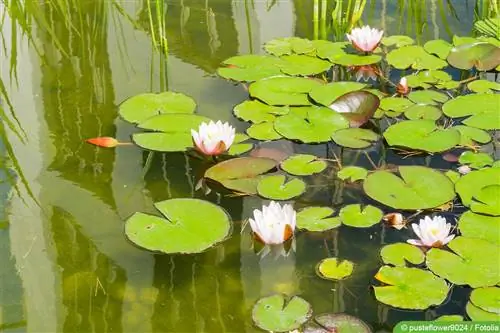
The more plants there are in the pond, the faster nutrients can be bound and the less food is left for algae. That's why it's advisable to always plant aquatic plants that enjoy phosphate and nitrate. Different plants are suitable for this:
Fast-growing pond plants
- Hornblatt
- Waterplague
- Thousandleaf
- Water screw
River Zone
- Waterrush
- Loosestrife
- Small Cattail
- Iris
Water surface
- Fresh bite
- crab scissors
- duckweed
Note:
So that the nutrients are removed from the nutrient cycle, the plants should be cut back regularly. The clippings can then be disposed of in the compost.
Preventive measures
Algae can be destroyed very easily, but it is of course always desirable if they do not appear in the first place. Although they cannot be completely avoided, there are effective precautionary measures that can significantly reduce the risk of algae infestation.
Pond shape
Many pond owners choose a pond with a depression because it looks the most natural. Unfortunately, such a shape also means that mineral fertilizer and garden soil are washed into the pond. This in turn can affect the phosphate content and promote algae development. For this reason, it is advisable to consider the following when considering the shape of the pond:
- It is best to choose a place with a slight elevation
- Pond surrounded by drainage ditch, approx. 60 cm deep
- Fill the trench with coarse-grained building sand
- Keep the water moving! (Fountains or watercourses)
Did you know?
Algae are more common in small and shallow waters.
Light conditions
High temperatures and a lot of sunlight promote the development of algae, which is why at least a third of a pond should be in the shade. A large awning, for example, is suitable as a shade source, but a high density of pond plants also offers protection from the sun's rays.
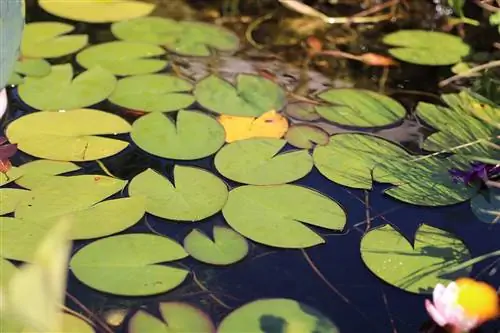
There are also numerous plants with large floating leaves that not only float decoratively on the surface of the water, but also offer protection from the sun's rays:
- Frogbite
- Lotus
- Seapot
- water lily
pH value
The ideal pH value of the water is between 6.8 and 8.2, although this is usually lower in the morning than in the evening. Normally, the pH value increases over the course of the day due to external influences, which in turn is a good sign that the pond environment is functioning. However, a pH value that is too high has a positive effect on algae development, which is why it should be checked regularly. If the pH value is too high, it can be reduced with simple measures:
- Put jute bags with peat in the water
- Connect firmly and attach to the edge of the pond
- If necessary, replace peat after 3 to 4 weeks
Alternatively, an oak branch can also be placed on the bottom, because the oak bark contains tannic acids, which lower the pH value. It is important that the branch is removed before it decomposes.

